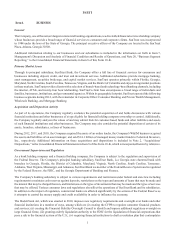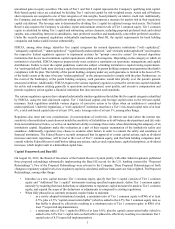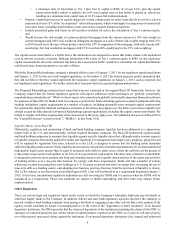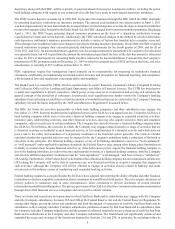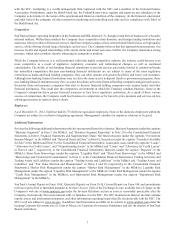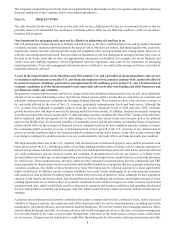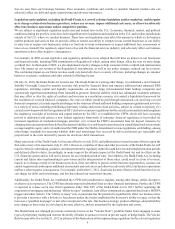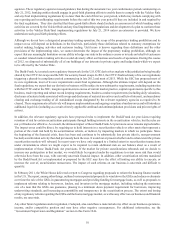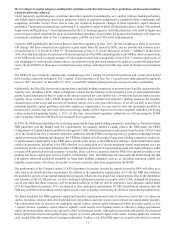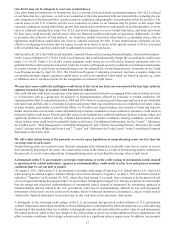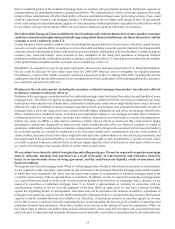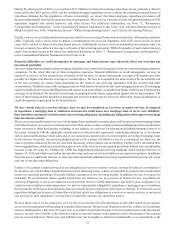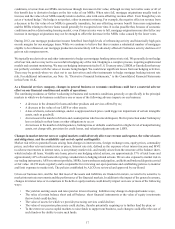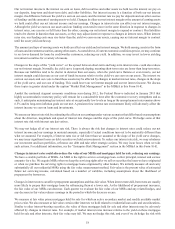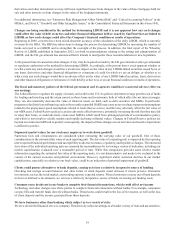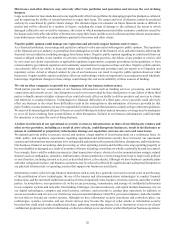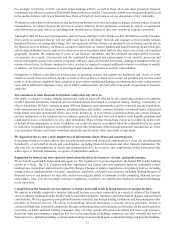SunTrust 2012 Annual Report Download - page 27
Download and view the complete annual report
Please find page 27 of the 2012 SunTrust annual report below. You can navigate through the pages in the report by either clicking on the pages listed below, or by using the keyword search tool below to find specific information within the annual report.11
We are subject to capital adequacy and liquidity guidelines and, if we fail to meet these guidelines, our financial condition
would be adversely affected.
Under regulatory capital adequacy guidelines and other regulatory requirements, we, together with our banking subsidiary
and broker-dealer subsidiaries, must meet guidelines subject to qualitative judgments by regulators about components, risk
weightings, and other factors. From time to time, the regulators implement changes to these regulatory capital adequacy
guidelines. The proposed rulemakings conforming U.S. regulatory capital to Basel III described in Item 1 under “Government
Supervision and Regulation,” when implemented by the U.S. banking agencies and fully phased-in, will result in higher and
more stringent capital requirements for us and our banking subsidiary. In particular, the proposed rulemakings will require us
to maintain a minimum ratio of Tier 1 common equity to RWA of at least 7.0% when fully phased-in.
Under the NPR published by the Federal Reserve and other regulators in June, 2012, the risk weighting of many of our assets
will change. We have estimated our regulatory capital under Basel III under the NPR, and we provide that estimate and a
reconcilement to U.S. GAAP in Table 39, "Reconcilement of Non-U.S. GAAP Measures" in Item 7, "MD&A", in this Form
10-K. Note that this estimate is consistent with our interpretation of the NPR, and ambiguities in the NPR or other interpretations
of the NPR could result in a larger measure of risk-weighted assets and consequently a lower Tier 1 common equity ratio. If
risk weightings of certain assets change, and we are required to hold increased amounts of capital as a result of holding those
assets, the profitability of those assets and businesses may change, and longer-term this may result in changes in our business
mix.
The NPR will also eventually eliminate the contribution to Tier 1 Capital of certain trust preferred and certain other hybrid
debt securities currently included in Tier 1 capital. These securities will lose Tier 1 Capital status under phased-in approach
between 2013 and 2016. At December 31, 2012, we had $627 million principal amount of such securities outstanding.
Additionally, the Basel III framework requires banks and bank holding companies to measure their liquidity against specific
liquidity tests, including a LCR, which is designed to ensure that the banking entity maintains a level of unencumbered high-
quality liquid assets greater than or equal to the entity's expected net cash outflow for a 30-day time horizon under an acute
liquidity stress scenario, and a NSFR, designed to promote more medium and long-term funding based on the liquidity
characteristics of the assets and activities of banking entities over a one-year time horizon. If we are not able to meet these
minimum liquidity capital guidelines and other regulatory requirements, we may need to alter our investment portfolio or
business mix, and this may adversely affect our earnings. Banks will be required to become compliant with the LCR during
a phase-in period beginning January 1, 2015. At this time, international regulatory authorities are still assessing the NSFR
and it is unclear when the NSFR will be introduced as a requirement.
In 2010, the FRB issued guidelines for evaluating proposals by large bank holding companies, including us. Pursuant to those
FRB guidelines and the Dodd-Frank Act requirements, we annually submit a capital plan to the FRB under the FRB's
Comprehensive Capital Analysis and Review program (CCAR), which incorporates requirements from Sections 165(i)(1) and
(2) of the Dodd Frank Act. Consistent with these guidelines and the FRB's existing supervisory guidance regarding internal
capital assessment, planning and adequacy, the FRB has adopted rules that require large bank holding companies, such as us,
to submit annual capital plans to the FRB and to provide prior notice to the FRB before making a capital distribution under
certain circumstances, including if the FRB objected to a capital plan or if certain minimum capital requirements were not
maintained. Further, our capital planning under CCAR requires an analysis of capital management and capital adequacy under
a variety of hypothetical stressed economic scenarios. There can be no assurance that the FRB will respond favorably to our
pending and future capital plan reviews. Further, in December, 2011, the FRB proposed rules under the Dodd-Frank Act that
will impose enhanced prudential standards on large bank holding companies such as us, including enhanced capital and
liquidity requirements, which may be similar to or more restrictive than those proposed by the BCBS.
The performance of the Company under CCAR's hypothetical scenarios dictates the capital actions the FRB will allow us to
take, such as dividends and share repurchases. In addition to the quantitative requirements of CCAR, the FRB also evaluates
the qualitative aspects of our capital management program, which can also impact our capital actions. Due to the importance
and intensity of the CCAR process, we have dedicated additional resources to comply with CCAR, although no assurance
can be provided that these resources will be deemed sufficient or that we will be deemed to have adequate capital under
CCAR's hypothetical scenarios. If we are deemed to have inadequate capital under CCAR's hypothetical scenarios, then the
FRB may prohibit us from taking certain capital actions, such as paying or increasing dividends or repurchasing capital stock.
The Basel standards and FRB regulatory capital and liquidity requirements may limit or otherwise restrict how we utilize our
capital, including common stock dividends and stock repurchases, and may require us to increase our capital and/or liquidity.
Any requirement that we increase our regulatory capital, replace certain capital instruments which presently qualify as Tier
1 capital, increase regulatory capital ratios or liquidity could require us to liquidate assets or otherwise change our business
and/or investment plans, which may adversely affect our financial results. Although not currently anticipated, the proposed
Basel capital rules and/or our regulators may require us to raise additional capital in the future. Issuing additional common
stock would dilute the ownership of existing stockholders. Further, even if the FRB approves a capital plan which we submit


